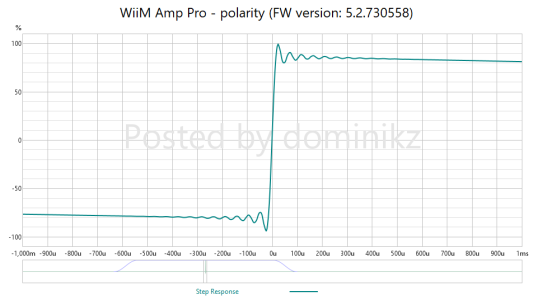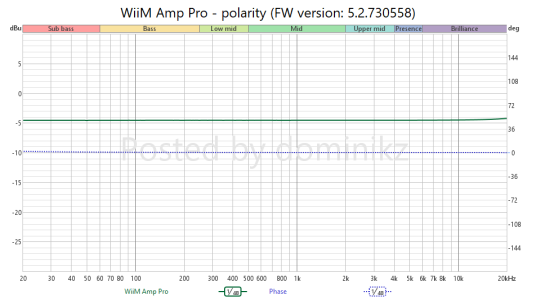dominikz
Major Contributor
- Joined
- Dec 31, 2024
- Messages
- 732
Hello all,
Beware: This thread will contain a lot of measurements and technical analysis. Continue reading at your own risk!
Introduction
Until the end of last year I used a Denon Ceol RCD-N9 integrated stereo receiver/amplifier to power my living room system consisting of pair of Revel M16 loudspeakers and a single SVS SB1000 (non-Pro) subwoofer. Denon lacked a lot of the functions I was after (PEQ, HDMI-ARC, solid app control - among other things), resulting in a clunky overall system - and to top it off it objectively measured disappointingly; being relatively low-powered with significant noise and distortion, and very load-sensitive (more on this later).
So even since the original WiiM Amp came out I was eyeing it as a potential replacement, which had most of the features needed to simplify my system significantly - not to mention better objective performance.
My main reservations at the time were the number of PEQ bands (there were originally only 4, and they were common to both channels), and lack of PFFB (meaning some minor load-sensitivity at higher frequencies). I decided to wait and see.
End of last year WiiM extended the number of PEQ bands to 2x10, and introduced the updated WiiM Amp Pro, which had PFFB and demonstrated even better objective performance. So I bought the WiiM Amp Pro during the BF sale in 2024, and have been using it happily ever since.
That is, I used it until recently when WiiM kindly reached out to me and asked me if I'd be willing to test the even newer WiiM Amp Ultra. I agreed, they shipped it to me, and so I've been using the Amp Ultra instead of the WiiM Amp Pro for the last few weeks.
Scope
Most of the measurements shown will be for the two WiiM amps, but I will add a few for the Denon as well, where I feel it might be interesting to compare.
I have focused my measurement efforts on a few key metrics, and those that may not be covered in other reviews of these devices:
Note also that I didn't measure maximum power for the WiiM amplifiers; mainly because my current dummy load cannot dissipate that much heat - but maximum power was anyway measured by other reviewers.
In addition, I have performed a series of both informal and rigorous controlled listening tests of these amplifiers.
These will be explained and links provided to some listening tests you can try yourselves - but in a new thread once I find the time.
Let me also provide links to detailed measurements of each amplifier under test:
Estimated maximum output voltage:
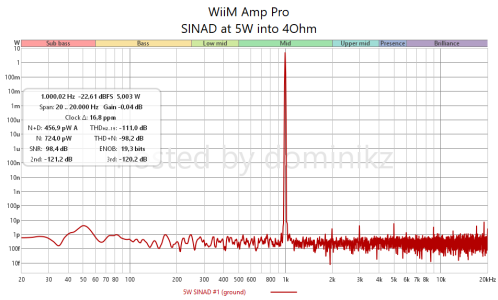
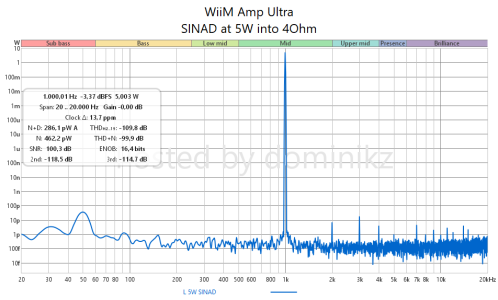
We can see above that SINAD of both amplifiers is actually very similar, very close to 100dB.
Note: Only the left channel is shown for each amp.
Multitone response
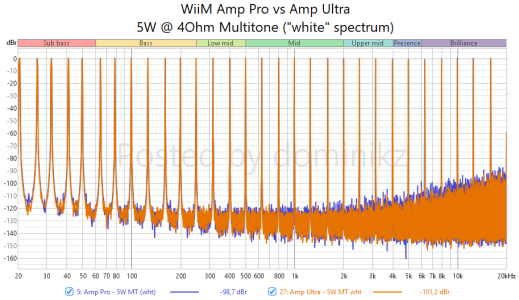
Both tested WiiM amps show almost identical multitone response at 5W, with slightly rising distortion/grass at the very high frequencies.
ENOB is 17,2 bits for Amp Pro and 17,7 bits for Amp Ultra.
It is perhaps interesting to compare with ENOB of the Denon which is only 10,8 bits.
However, I was never a fan of such "white" spectrum multitone measurements, as realistic signals like music have a falling spectrum with frequency (i.e. closer to "pink" spectrum).
So here's the same thing with "pink" spectrum multitone signal:
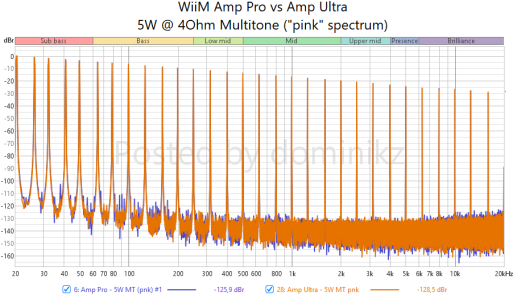
As we can see, with this signal spectrum (which is IMHO much more realistic) there's no increase in noise and distortion at higher frequencies.
ENOB is now 18,9 bits for Amp Pro and 19 bits for Amp Ultra.
Load (in)dependency / load sensitivity
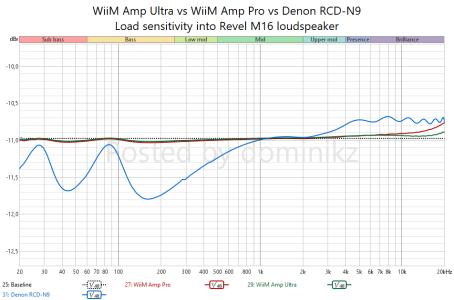
Please note that the total vertical scale in the above diagram is only 3dB - so every horizontal grid line is only 0,1dB - which makes the deviations seems severe.
Denon swings are up to 1dB (since it has a really unusually high output impedance), while for both WiiM amps the swings are tiny and almost identical in most of the audible spectrum - a benefit of PFFB implemented in both WiiM amps.
Here's the identical diagram, but using the "common" 50dB vertical scale - to get a better sense of the relatively magnitude of these deviations:
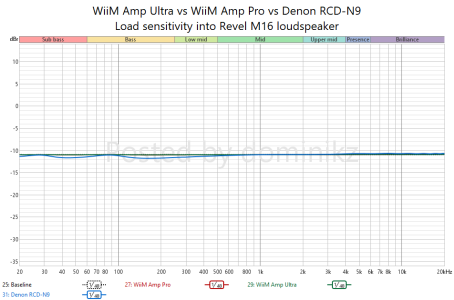
Here's how the various connected loads impact distortion (vs frequency):
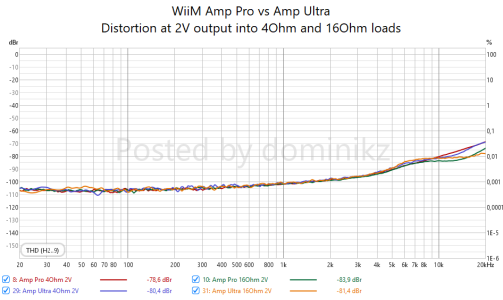
I.e. both amps' distortion is virtually insensitive to connected load (at least under normal operating conditions).
Absolute polarity
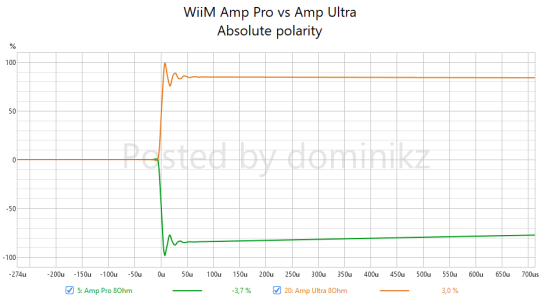
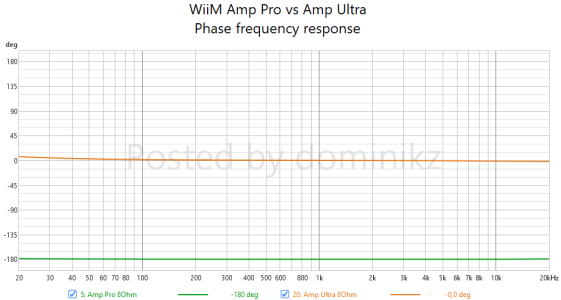
As we can see, WiiM Amp Pro inverts polarity at the loudspeaker terminals - I've raised a support ticket to WiiM about this, and they said it is a fault that will be fixed in a FW update.
WiiM Amp Ultra has correct polarity.
Grounding and 50-cycle hum
The WiiM Amp Ultra was reasonably insensitive to 50-cycle hum pickup in my measurements, likely due to having a three-prong cable for the power supply (i.e. it is grounded).
With the WiiM Amp Pro some 50-cycle hum was picked up unless I added an additional ground point to it (e.g. by connecting any RCA socket sleeve to an external ground).
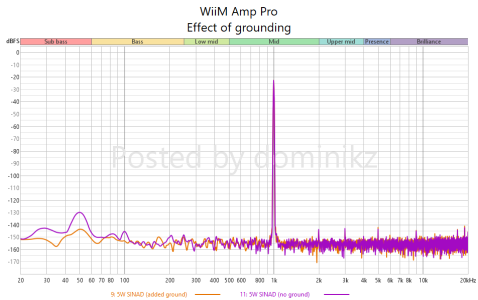
Output volume curve
I've measured this only on the Amp Pro - it shows how reducing the volume changes the output level in dB:

Note: Reference level for this test was 0 dBV with volume set to "100".
Note that this relationship looks similar to a previous result I got for the WiiM Mini (link) so I suspect this is similar for most WiiM devices.
Ultrasonic noise and misc

Above we can see that while both tested WiiM amps have relatively low level of ultrasonic noise, Denon has much more - suggesting very aggressive noise-shaping.
One thing I thought it is interesting to point out: both WiiM Amp Pro and Amp Ultra make a small 'pop' sound when going to standby. With the Denon there are no such noises.
Conclusions
After all this, some will surely ask "OK, but how does it sound?"- this however will be a topic for a new thread where I will talk about the listening tests I did.
So I will just summarize the objective performance differences of the Amp Pro and Amp Ultra the same I did in another thread:
Hope this will be interesting to the community!
Beware: This thread will contain a lot of measurements and technical analysis. Continue reading at your own risk!
Introduction
Until the end of last year I used a Denon Ceol RCD-N9 integrated stereo receiver/amplifier to power my living room system consisting of pair of Revel M16 loudspeakers and a single SVS SB1000 (non-Pro) subwoofer. Denon lacked a lot of the functions I was after (PEQ, HDMI-ARC, solid app control - among other things), resulting in a clunky overall system - and to top it off it objectively measured disappointingly; being relatively low-powered with significant noise and distortion, and very load-sensitive (more on this later).
So even since the original WiiM Amp came out I was eyeing it as a potential replacement, which had most of the features needed to simplify my system significantly - not to mention better objective performance.
My main reservations at the time were the number of PEQ bands (there were originally only 4, and they were common to both channels), and lack of PFFB (meaning some minor load-sensitivity at higher frequencies). I decided to wait and see.
End of last year WiiM extended the number of PEQ bands to 2x10, and introduced the updated WiiM Amp Pro, which had PFFB and demonstrated even better objective performance. So I bought the WiiM Amp Pro during the BF sale in 2024, and have been using it happily ever since.
That is, I used it until recently when WiiM kindly reached out to me and asked me if I'd be willing to test the even newer WiiM Amp Ultra. I agreed, they shipped it to me, and so I've been using the Amp Ultra instead of the WiiM Amp Pro for the last few weeks.
DISCLAIMER: WiiM Amp Ultra was sent to me for testing by the manufacturer. WiiM were kind enough to permit me to publicly publish my findings regarding the Amp Ultra, but the content is my own, based on my honest opinion and findings, and hasn't been in any way moderated by WiiM. The other two tested amps (WiiM Amp Pro and the Denon Ceol RCD-N9) I bought with my own money.
Scope
Most of the measurements shown will be for the two WiiM amps, but I will add a few for the Denon as well, where I feel it might be interesting to compare.
I have focused my measurement efforts on a few key metrics, and those that may not be covered in other reviews of these devices:
- SINAD at 5W into 4Ohm load
- Multitone response at 5W into 4Ohm load (both "white" and "pink" spectrum)
- Load (in)dependency (caused by output impedance)
- Absolute polarity
- Grounding and 50-cycle hum
- Volume curve
- Out of band (ultrasonic) noise
Note also that I didn't measure maximum power for the WiiM amplifiers; mainly because my current dummy load cannot dissipate that much heat - but maximum power was anyway measured by other reviewers.
In addition, I have performed a series of both informal and rigorous controlled listening tests of these amplifiers.
These will be explained and links provided to some listening tests you can try yourselves - but in a new thread once I find the time.
Let me also provide links to detailed measurements of each amplifier under test:
- WiiM Amp Pro - Amir's review on ASR
- WiiM Amp Ultra - Erin's review on EAC
- Note: Erin fed the Amp Ultra analogue input for his measurements. This is why his Amp Ultra noise/distortion results look worse than those for the Amp Pro on ASR (Amir fed the optical in).
- Denon Ceol RCD-N9 - my own review on ASR
- E1DA Cosmos ADC (mostly using the 2,5mm TRRS Aux input set to "10V" setting, stereo mode, 192kHz sample rate and 24bit depth), B-grade, SNR about 124dB in stereo mode / about 127dB in mono mode
- RME Babyface Silver Edition mostly used as a digital signal generator via optical (SPDIF) output
- KoordASIO drivers (192kHz sample rate)
- Room EQ Wizard (REW) software for measurements
- PreSonus Studio One Professional v6.6 DAW software for audio recording
- DeltaWave Audio Null Comparator software for recorded file comparison
- DIY resistive dummy load (4Ohm, 8Ohm and 16Ohm)
- UNI-T UT60E true RMS multimeter and Parkside PZM 2 A2 pen multimeter
- UNI-T UT353 mini sound level meter
- Digital Sound 8930B IEC 60942:2018 class II standard sound calibrator
- miniDSP UMIK-1 calibrated measurement microphone
- Samsung Galaxy S23+ mobile phone as a streaming source
Estimated maximum output voltage:
- WiiM Amp Pro: 21,8 Vrms / 29 dBu
- WiiM Amp Ultra: 28,6 Vrms / 31,4 dBu
- Denon Ceol RCD-N9: 16,8 Vrms / 26,7 dBu


We can see above that SINAD of both amplifiers is actually very similar, very close to 100dB.
Note: Only the left channel is shown for each amp.
Multitone response

Both tested WiiM amps show almost identical multitone response at 5W, with slightly rising distortion/grass at the very high frequencies.
ENOB is 17,2 bits for Amp Pro and 17,7 bits for Amp Ultra.
It is perhaps interesting to compare with ENOB of the Denon which is only 10,8 bits.
However, I was never a fan of such "white" spectrum multitone measurements, as realistic signals like music have a falling spectrum with frequency (i.e. closer to "pink" spectrum).
So here's the same thing with "pink" spectrum multitone signal:

As we can see, with this signal spectrum (which is IMHO much more realistic) there's no increase in noise and distortion at higher frequencies.
ENOB is now 18,9 bits for Amp Pro and 19 bits for Amp Ultra.
Load (in)dependency / load sensitivity

Please note that the total vertical scale in the above diagram is only 3dB - so every horizontal grid line is only 0,1dB - which makes the deviations seems severe.
Denon swings are up to 1dB (since it has a really unusually high output impedance), while for both WiiM amps the swings are tiny and almost identical in most of the audible spectrum - a benefit of PFFB implemented in both WiiM amps.
Here's the identical diagram, but using the "common" 50dB vertical scale - to get a better sense of the relatively magnitude of these deviations:

Here's how the various connected loads impact distortion (vs frequency):

I.e. both amps' distortion is virtually insensitive to connected load (at least under normal operating conditions).
Absolute polarity


As we can see, WiiM Amp Pro inverts polarity at the loudspeaker terminals - I've raised a support ticket to WiiM about this, and they said it is a fault that will be fixed in a FW update.
WiiM Amp Ultra has correct polarity.
Grounding and 50-cycle hum
The WiiM Amp Ultra was reasonably insensitive to 50-cycle hum pickup in my measurements, likely due to having a three-prong cable for the power supply (i.e. it is grounded).
With the WiiM Amp Pro some 50-cycle hum was picked up unless I added an additional ground point to it (e.g. by connecting any RCA socket sleeve to an external ground).

Output volume curve
I've measured this only on the Amp Pro - it shows how reducing the volume changes the output level in dB:

Note: Reference level for this test was 0 dBV with volume set to "100".
Note that this relationship looks similar to a previous result I got for the WiiM Mini (link) so I suspect this is similar for most WiiM devices.
Ultrasonic noise and misc

Above we can see that while both tested WiiM amps have relatively low level of ultrasonic noise, Denon has much more - suggesting very aggressive noise-shaping.
One thing I thought it is interesting to point out: both WiiM Amp Pro and Amp Ultra make a small 'pop' sound when going to standby. With the Denon there are no such noises.
Conclusions
After all this, some will surely ask "OK, but how does it sound?"- this however will be a topic for a new thread where I will talk about the listening tests I did.
So I will just summarize the objective performance differences of the Amp Pro and Amp Ultra the same I did in another thread:
- Amp Ultra has approx. 2,4dB higher output voltage compared to Amp Pro when set to the same output volume and using the same input signal level.
- This difference in output level will be clearly audible, but might appear 'different' rather than clearly 'louder' to some listeners.
- This means that direct listening comparisons of the two amps will likely be tainted by the loudness difference.
- This difference can be equalized in several ways, but probably the easiest that is reasonably precise is to feed both amps with the same 100Hz sine wave, and measure the output at the binding posts with a true RMS multimeter. Adjust the output volume on either amp until the measured output voltage is identical on both amps.
- Amp Ultra preserves absolute signal polarity while Amp Pro inverts it on the loudspeaker output binding posts.
- Interestingly the polarity is not inverted on the Amp Pro subwoofer output. I've opened a support ticket regarding all this and got the answer that loudspeaker output polarity will be corrected in one of the future Amp Pro firmware updates.
- Until the firmware update is released, the polarity inversion issue of the Amp Pro can of course be worked-around by switching the loudspeaker cable polarity at the binding posts.
- Amp Ultra is a tiny bit less load-sensitive above 10kHz compared to Amp Pro.
- With my Revel M16 loudspeakers there's 0,2dB maximum difference between them at 20kHz, and no difference at all below 10kHz.
- Amp Ultra's power supply has a ground connection, while Amp Pro's does not.
- This means that one might pick up ground loops and 50/60 cycle hum where the other doesn't.
Hope this will be interesting to the community!

